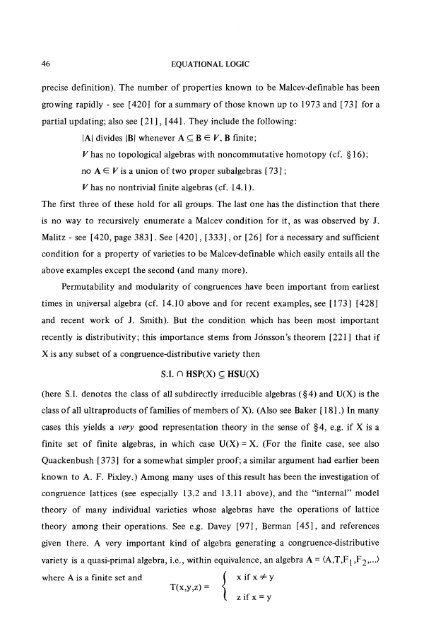Survey 1979: Equational Logic - Department of Mathematics ...
Survey 1979: Equational Logic - Department of Mathematics ...
Survey 1979: Equational Logic - Department of Mathematics ...
You also want an ePaper? Increase the reach of your titles
YUMPU automatically turns print PDFs into web optimized ePapers that Google loves.
46 EQUATIONAL LOGIC<br />
precise definition). The number <strong>of</strong> properties known to be Malcev-definable has been<br />
growing rapidly - see [420] for a summary <strong>of</strong> those known up to 1973 and [73] for a<br />
partial updating; also see [21 ], [44]. They include the following:<br />
IAI divides IBI whenever A C_ B G V, B finite;<br />
V has no topological algebras with noncommutative homotopy (cf. õ 16);<br />
no A G V is a union <strong>of</strong> two proper subalgebras [ 73 ];<br />
V has no nontrivial finite algebras (cf. 14.1).<br />
The first three <strong>of</strong> these hold for all groups. The last one has the distinction that there<br />
is no way to recursively enumerate a Malcev condition for it, as was observed by J.<br />
Malitz - see [420, page 383]. See [420], [333], or [26] for a necessary and sufficient<br />
condition for a property <strong>of</strong> varieties to be Malcev-definable which easily entails all the<br />
above examples except the second (and many more).<br />
Permutability and modularity <strong>of</strong> congruences have been important from earliest<br />
times in universal algebra (cf. 14.10 above and for recent examples, see [173] [428]<br />
and recent work <strong>of</strong> J. Smith). But the condition which has been most important<br />
recently is distributivity; this importance stems from J6nsson's theorem [221] that if<br />
X is any subset <strong>of</strong> a congruence-distributive variety then<br />
S.I. c HSP(X) c_ HSU(X)<br />
(here S.I. denotes the class <strong>of</strong> all subdirectly irreducible algebras (õ4) and U(X) is the<br />
class <strong>of</strong> all ultraproducts <strong>of</strong> families <strong>of</strong> members <strong>of</strong> X). (Also see Baker [ 18 ] .) In many<br />
cases this yields a very good representation theory in the sense <strong>of</strong> õ4, e.g. if X is a<br />
finite set <strong>of</strong> finite algebras, in which case U(X) = X. (For the finite case, see also<br />
Quackenbush [373] for a somewhat simpler pro<strong>of</strong>; a similar argument had earlier been<br />
known to A. F. Pixley.) Among many uses <strong>of</strong> this result has been the investigation <strong>of</strong><br />
congruence lattices (see especially 13.2 and 13.11 above), and the "internal" model<br />
theory <strong>of</strong> many individual varieties whose algebras have the operations <strong>of</strong> lattice<br />
theory among their operations. See e.g. Davey [97], Berman [45], and references<br />
given there. A very important kind <strong>of</strong> algebra generating a congruence-distributive<br />
variety is a quasi-primal algebra, i.e., within equivalence, an algebra A = (A,T,F 1 ,F2,...)<br />
T(x,y,z) =<br />
where A is a finite set and { x zifx=y<br />
if x % y

















